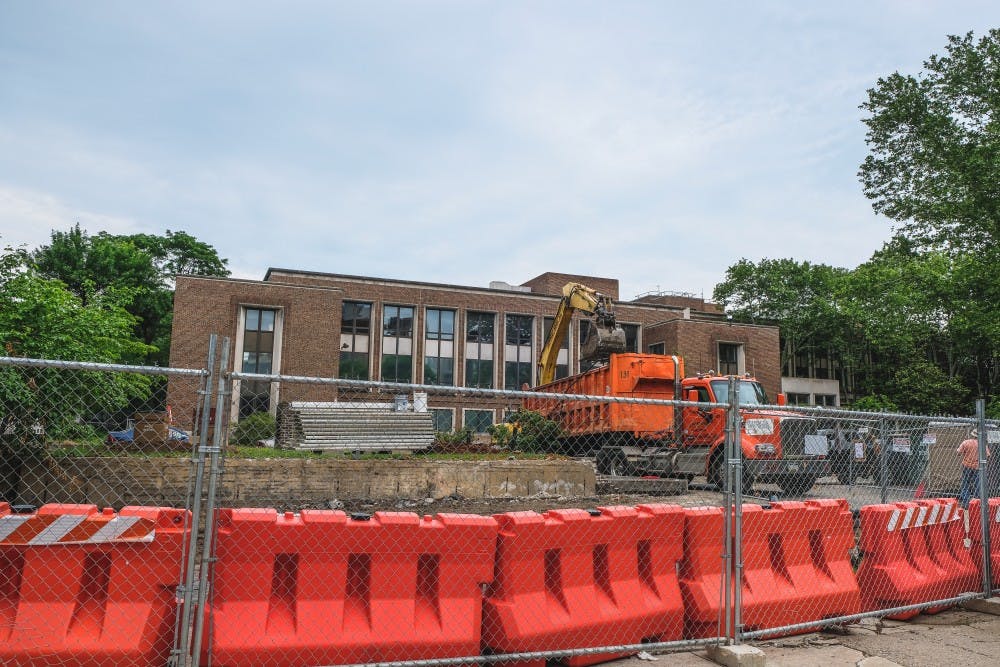Summer is a busy time for construction at Penn, as both routine repairs and major projects get a head start while most students are off campus. This summer, construction projects include repairs to sidewalks, updates to building facades, and renovations of academic facilities.
“We generally do more [construction] during the summer because that is when we do a lot of our exterior projects,” Design and Construction Executive Director Mike Dausch said. “We try not to do that type of work, or not to do nearly as much of it, during the academic year.”
Dausch said that the sidewalk around Hill College House is being replaced and the nearby parking lot is being converted to a garden.
In addition to these small repairs, several major building projects are being completed over the summer.
A $15.15 million renovation to Houston Market began in May and will be finished by the end of August. As part of the renovation, Houston Market’s seating layout will be altered and electronic payment kiosks will be added. New food options such as a cafe, pizza station, and a Mongolian grill will also be offered.
“The whole space will be modernized,” Facilities and Real Estate Services (FRES) principal planner Mark Kocent said, adding that Houston Market’s kitchen, serving areas, and seating areas will all be renovated.
The planners stressed that this renovation could only be done over the summer.
“We really can’t take a dining facility out of service during the academic year,” Dausch said.
Related:
'Power of Penn' campaign plans to bring eight new buildings to campus
Beneath Penn property could lie the burials of West Philadelphia's earliest black residents
Over 250 students denied housing in New College House next year to make way for new freshmen
Similarly, Kocent said that FRES has “a very short window from graduation until the return of students in August to complete a lot of work.”
The Perelman Center for Political Science and Economics is also almost completed. Construction of the $77.6 million building began in February 2016 and was substantially completed in May 2018, four months after the original January 2018 estimate. Kocent said that the Political Science and Economics departments are moving into the building over the summer and that classes will start there in the fall semester.
The first 10 stories of a new building at 3600 Civic Center Boulevard will also be completed this fall, housing a café, day care center, and Penn Medicine offices and labs. Dausch said that employees will begin moving into the new offices in November or December.
“As floors are finished, tenants will move in from other locations on campus,” he added.
In addition, construction has begun on several buildings financed by the "Power of Penn" campaign, which began in March and is set to continue until 2021. These include the Wharton Academic Research building, New College House West, the Pavilion at the Hospital of the University of Pennsylvania, the Penn Museum, and the Evans Main Dental Clinic.
Kocent said that construction of the Wharton Academic Research building began in May 2018 and will be completed in August 2020. This academic facility, located at 37th and Spruce streets, will be built above a renovated electrical substation that will provide power to 30 campus buildings.
As part of the project, the University will renovate Woodland Walk between 36th and 37th streets.
“Instead of being one straight pathway, it’s going to be sort of a series of little parks that you can walk through to connect the Quad and the Love statue,” Dausch said. He added that this was in line with the area’s original design.
Kocent said that the University hopes to open the part of Woodland Walk near 36th Street by the end of the summer, but the rest of the block will be closed until the Wharton building’s completion in 2020.
Several other Power of Penn projects are in various phases of construction.
New College House West is scheduled for completion in August 2021 and should be ready for occupancy in the following school year. The residential building, which was approved by Penn’s trustees in November 2017, will cost the University a record-breaking $168 million.
Kocent added that in the Dental School, renovations to the Evans Building were completed this past December, and the new Schattner building was substantially completed in June.
Additionally, the Penn Medicine Pavilion, a $1.5 billion hospital building that will be added to the Hospital of the University of Pennsylvania, should be ready for occupancy by the 2021 calendar year. A $21.92 million renovation of the Coxe and Harrison wings of the Penn Museum is also set to be completed in September 2019.
However, the construction process has not started for several other Power of Penn buildings. These include a student pavilion for the Graduate School of Education, a science research building focused on energy research, the Venture Lab, and an indoor training facility.
Regarding these projects, Dausch said that “fundraising is still ongoing to afford their construction.”
Other current construction projects include a $33.15 million renovation to the Richards building which is set to be completed in December 2018, as well as a $123.25 million renovation to the Stemmler lab building which is scheduled for completion in January 2019. Additionally, the Ringe Squash Center will undergo a $18.7 million renovation to be completed in July 2019.
While these projects are mainly being built during the summer, construction will continue throughout the academic year.
“Even though we do a lot of those exterior projects in the summer, the big building construction projects are year round,” Dausch said.



